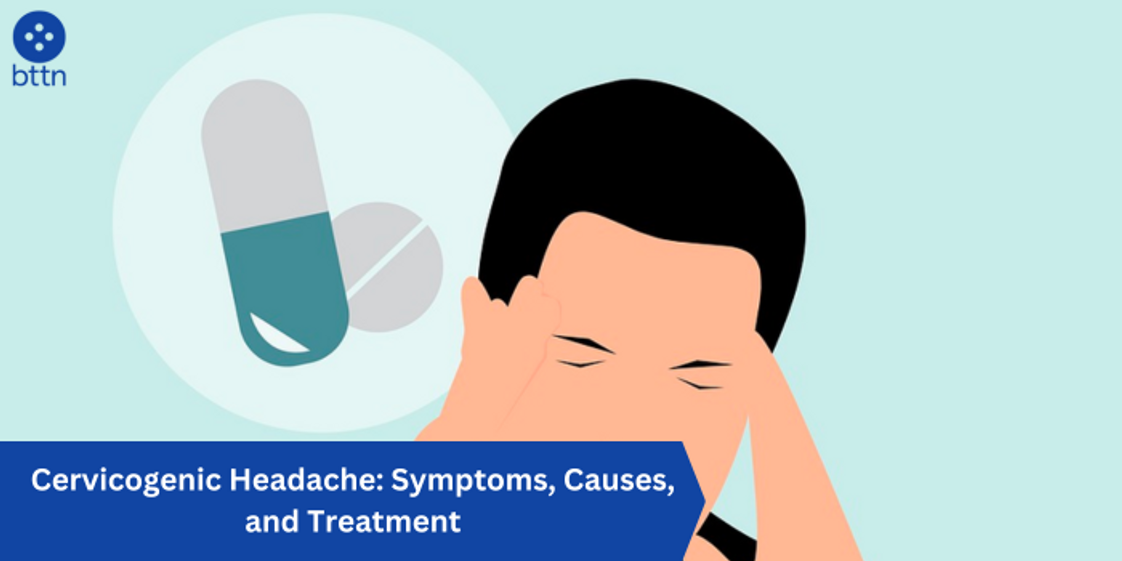
Cervicogenic Headache: Symptoms, Causes, and Treatment
Posted by Pankaj Dhiman on Mar 3rd 2024
Do you experience headaches that originate at the back of your head and radiate upwards? You might be suffering from cervicogenic headaches. These headaches, though often mistaken for migraines, stem from issues within the neck and upper spine.
This blog delves into cervicogenic headaches, exploring their symptoms, causes, diagnosis, and treatment options. We'll also discuss potential complications and offer tips for headache management.
What Is a Cervicogenic Headache?
A cervicogenic headache originates in the structures of your upper spine, specifically the muscles, joints, and nerves in your neck. These structures, when irritated or inflamed, can trigger pain that radiates upwards towards the head.
Cervicogenic headaches can be a real nuisance, causing significant discomfort and impacting daily life. While often manageable, seeking proper diagnosis and treatment is crucial to prevent complications and ensure optimal well-being.
Must Read: 12 Best-Selling Wound Care Products in the US (2024)
Cervicogenic Headache Symptoms:
Several telltale signs differentiate cervicogenic headaches from other types of headaches:
- Pain location: The pain typically originates in the back of the head and neck, often on one side, and may radiate upwards towards the forehead or temple.
- Pain characteristics: The pain is usually described as a dull ache or ache-like pressure, unlike the throbbing often associated with migraines.
- Neck stiffness: Limited neck movement and stiffness are common accompanying symptoms.
- Pain aggravation: Activities that put stress on the neck, such as coughing, sneezing, or maintaining awkward postures, can worsen the pain.
- Other associated symptoms: Dizziness, nausea, and sensitivity to light and sound may sometimes occur, although less frequently than with migraines.
Must Read: At-Home Drug Tests: What They Are and How They Work
Cervicogenic Headache Causes:
Various factors can contribute to cervicogenic headaches:
- Muscle strain and tension: Overexertion, poor posture, or repetitive neck movements can strain neck muscles, leading to pain and referred headaches.
- Joint problems: Degenerative conditions like osteoarthritis or disc herniation in the cervical spine can irritate surrounding nerves and cause headaches.
- Neck injuries: Whiplash, sports injuries, or other traumas to the neck can damage muscles, ligaments, or nerves, triggering cervicogenic headaches.
- Cervical spine malformations: Congenital abnormalities in the vertebrae of the neck can contribute to cervicogenic headaches.
Must Read: 10 Best-Selling Gauze Sponges in the US 2024
Cervicogenic Headache Diagnosis:
Diagnosing cervicogenic headaches often involves a combination of:
- Medical history review: Your doctor will discuss your symptoms, medical history, and any potential risk factors.
- Physical examination: This includes assessing your neck movement, range of motion, tenderness, and any muscle trigger points.
- Diagnostic tests: In some cases, imaging tests like X-rays, MRIs, or CT scans may be necessary to rule out other underlying conditions.
Cervicogenic Headache Treatment:
Fortunately, various treatment options can effectively manage cervicogenic headaches:
Medications to Treat Cervicogenic Headaches:
- Over-the-counter pain relievers: Medications like ibuprofen, acetaminophen, or naproxen can help alleviate pain and inflammation.
- Muscle relaxants: These medications can help relax tense muscles and reduce pain.
- Tricyclic antidepressants: In some cases, these medications have been found to be effective in preventing cervicogenic headaches.
Must Read: Cervical Pain: Causes, Treatment, and Prevention
Home Remedies for Cervicogenic Headache Treatment:
- Rest: Allow your body adequate rest to promote healing and reduce pain.
- Heat therapy: Applying a warm compress to your neck can help relax muscles and ease pain.
- Ice therapy: Applying ice packs to your neck for short periods can also help reduce inflammation and pain.
- Posture correction: Maintaining good posture while sitting, standing, and sleeping can significantly prevent strain on your neck muscles.
- Stretching and gentle exercises: Regularly performing neck stretches and exercises recommended by a healthcare professional can improve flexibility and reduce muscle tension.
Cervicogenic Headache Complications:
While rare, potential complications associated with cervicogenic headaches include:
- Chronic pain: Untreated cervicogenic headaches can become chronic, leading to persistent pain and affecting daily life.
- Neurological problems: In severe cases, nerve compression in the neck might lead to numbness, tingling, or weakness in the arms or hands.
- Depression and anxiety: Chronic pain can contribute to mental health concerns like depression and anxiety.
Must Read: 12 Best Selling Wound Care Products in US
Conclusion:
Cervicogenic headaches can be a cause of significant discomfort, but they are often manageable with proper diagnosis and treatment. If you experience persistent headaches originating in your neck, consult a healthcare professional for an accurate diagnosis and personalized treatment plan. Remember, early intervention and maintaining good posture can significantly improve your chances of preventing and managing cervicogenic headaches.
